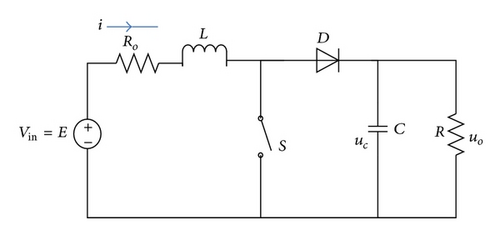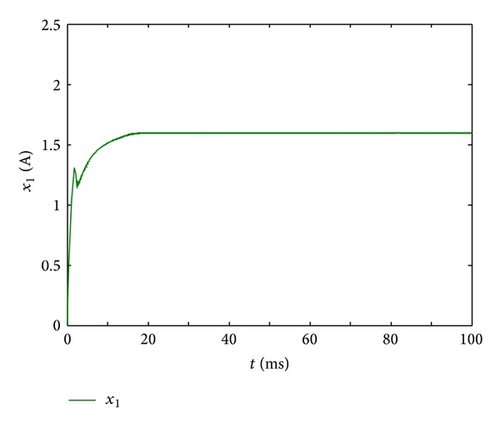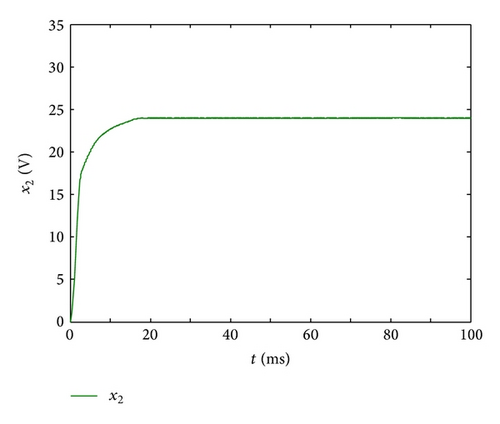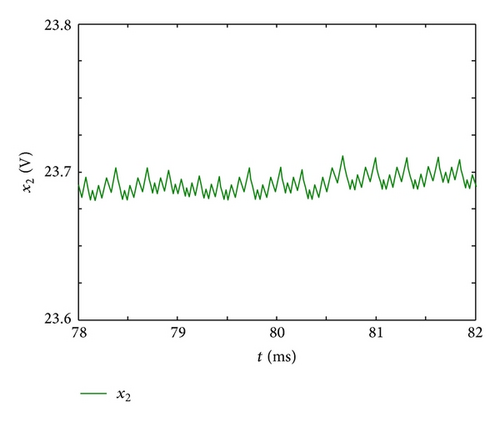Robust H∞ Switching Rule Design for Boost Converters with Uncertain Parameters and Disturbances
Abstract
This paper is concerned with the design problem of robust H∞ switching rule for Boost converters with uncertain parameters and disturbances. Firstly, the Boost converter is modeled as a switched affine linear system with uncertain parameters and disturbances. Then, using common Lyapunov function approach and linear matrix inequality (LMI) technique, a novel switching rule is proposed such that the H∞ model reference tracking performance is satisfied. Finally, a simulation result is provided to show the validity of the proposed method.
1. Introduction
The last years have witnessed the crescent interest of the scientific community in the study of hybrid systems because of their wide applications in many fields, such as chemical processing, communication networks, traffic control, automotive engine control, and aircraft control [1–4]. The stochastic hybrid systems, also called Markov jump systems, represent an important class of hybrid systems that are popular in modeling many practical systems, such as manufacturing systems, power systems, aerospace systems, and networked control systems that may experience random abrupt changes in their structures and parameters [5–8]. Recently, the problem of the adaptive tracking for a class of stochastic nonlinear systems with stationary Markovian switching was considered in [9]. The problem of robust mode-dependent delayed state feedback H∞ control for a class of uncertain time-delay systems with Markovian switching parameters and mixed discrete, neutral, and distributed delays was investigated in [10].
As a specific type of hybrid systems, switched systems have received a great attention in the last decades. Many examples of such systems can be found in real world, such as power electronics, networked control systems [11]. The switching rule design is one of the key issues in the study of switched systems. Based on the switching rule design, many important problems, such as stability, model reduction, H∞ control or filtering problem, and tracking control, have been extensively investigated in [12–22]. For example, the problems of stability and stabilization of impulsive switched systems with time delays were considered in [12]. The problems of finite-time stability analysis and stabilization for switched nonlinear discrete-time systems were addressed in [13]. The model reduction of switched systems was investigated in [14, 15]. In [16–22], the H∞ control and filtering problems of switched systems were studied. In [23], the tracking control for switched linear systems with time delay was investigated, and a tracking control law was designed such that the H∞ model reference tracking performance is satisfied. There are also many papers discussing the switching rule design for switched affine systems; see, for instance, [24–26] and the references therein.
On the other hand, the switch-mode DC-DC converters are widely applied in DC motor drives and regulated DC power supplies where the object is to convert the unregulated DC input into a desired DC output voltage level [27]. Due to the fact that the DC-DC converters operate in a switch mode where an interaction between continuous and discrete dynamics exists, they can be modeled as hybrid systems. Recently, a unified method for fast modeling of DC-DC switching converters in the continuous conduction mode and discontinuous conduction mode was proposed in [28]. A tristate converter was modeled as a switched affine system, and a controller was designed to ensure that the corresponding closed-loop system is always stable in the safe set [29]. In [27], a hybrid feedback switching rule based on the common Lyapunov function approach was applied to a Buck converter. The method dealing with switched affine systems was used to study DC-DC converters, and a set of equilibrium points and a class of switching rules were determined in [30, 31]. In order to improve the switching strategy, the clock delay control was discussed in [32]. In addition, the method of state feedback H∞ controller design for Monrovian switching systems with mixed delays was applied to DC-DC converters in [33]. However, DC-DC converters with uncertain parameters and disturbances have not yet gained sufficient research attention, which motivates the present study.
In this paper, we are interested in investigating the robust H∞ switching rule design for Boost converters with uncertain parameters and disturbances. Firstly, the Boost converter under consideration is modeled as a switched affine system. Then the common quadratic Lyapunov function approach is utilized for the design of switching rule. By determining a set of attainable equilibrium points, a class of switching rules and the activation region of each subsystem are developed. A sufficient condition for the existence of such switching rule guaranteeing the H∞ model reference tracking performance is formulated in terms of linear matrix inequality (LMI).
The rest of this paper is organized as follows. Section 2 presents the model of switched affine linear system for a Boost converter with uncertain parameters and disturbances. In Section 3, a switching rule is designed such that the H∞ model reference tracking performance is satisfied. The simulation result is illustrated through a numerical example in Section 4. Brief conclusion is discussed in Section 5.
Notations. Rn denotes the n-dimensional Euclidean space, and Rn×n is the set of n × n real matrices. For real matrices or vectors, the superscript “T” stands for the transpose. The convex combination is given by , where λ belongs to the set of Λ composed by all nonnegative vectors such that . The space of square integrable functions on [0, ∞) is denoted by L2[0, ∞).
2. Model of Boost Converter
A Boost converter with the inductor equivalent series resistance (ESR), uncertain parameters, and disturbance is shown in Figure 1.

3. Switching Rule Design
The problem concerned here is to design a switching rule σ(t) and determine an equilibrium point xr ∈ Rn that is attainable under such switching rule, that is, x(t) → xr as t → ∞. Furthermore, the switching rule should guarantee the H∞ model reference tracking performance.
Assumption 1. The uncertainty ΔAi is given as follow:
Definition 2. Given a constant γ > 0, error switched system (8) is said to be stabilizable with an H∞ disturbance attenuation γ if there exists a switching rule σ(t) such that the following conditions are satisfied:
- (1)
system (8) with ω(t) ≡ 0 is asymptotically stable for all admissible uncertainties;
- (2)
under zero-initial condition, that is, x(0) = 0,
()
Lemma 3 (see [31].)Consider switched system (7) with bσ(t) ≡ 0, if there exist λ ∈ Λ and a symmetric positive-definite matrix P ∈ Rn×n such that
Lemma 4 (see [24].)Consider switched affine linear system (7) with m = 2; the point xr = 0 is a quadratic stabilizable switched equilibrium if and only if there exists α ∈ (0,1) such that
Lemma 5 (see [34].)If X and Y are constant matrices of appropriate dimensions, then
The following theorem provides an LMI condition for designing the switching rule σ(t) such that error system (8) is stabilizable with an H∞ disturbance attenuation γ.
Theorem 6. Let xr be a given constant vector representing the desired equilibrium point of the system (7), and consider error switched system (8). Given constants γ > 0 and ε > 0, if there exist λ ∈ Λ and a symmetric positive definite matrix P ∈ Rn×n such that
Proof. Choose the following Lyapunov function:
For any t ≥ 0, the feasibility of (18) implies , which ensures the asymptotic stability of system (8) with ω(t) ≡ 0.
On the other hand, denote that {(tk, σ(tk))∣k = 0,1, …, s; 0 = t0 ≤ t1 ≤ ⋯≤ts < tf} as the switching sequence of σ(t) on the interval [0, tf). Under zero condition, we have
This completes the proof.
From Theorem 6, it can be seen that (18) is a LMI; thus we can first get the matrix P through LMI toolbox of MATLAB [35]. Then the desired switching rule can be obtained from (20) for any selected equilibrium point xr.
Remark 7. In Theorem 6, a method of robust H∞ switching rule design is proposed for Boost converters. It is worth pointing out that the proposed design method can also be applied to other types of converters that can be described by switched affine system models, such as Buck converters and Buck-Boost converters.
Remark 8. It can be seen from (34) that the matrix P is necessary to the implementation of the switching rule (34); because the matrix P defined in Theorem 6 does not depend on each λ ∈ Λ associated with xr. Hence, for any equilibrium point selected by the designer, the matrix P can be derived from (18), and consequently, the switching rule (34) can be implemented in practice.
4. Simulation Results
From (34), the desired switching rule can be derived. Figures 2–4 shows the response of the previous Boost converter, where the initial state is given by .



From Figures 2 and 3, it can be observed that the inductor current and capacitance voltage uc can track the reference current and the reference voltage rapidly, respectively. Therefore, the converter with the switching rule (34) has an H∞ model reference tracking performance. This demonstrates the effectiveness of the proposed result.
In addition, for this example, when the value of γ is decreased to 393, the feasible solution of (18) cannot be found. Thus, it can be obtained that a larger γ is favorable for the feasibility of matrix inequality (18). On the other hand, we can get from Remark 8 that the solution of (18) does not dependent on the equilibrium point xr. But the proposed switching rule depends on the equilibrium point xr, which can be seen from (34).
5. Conclusions
The problem of robust H∞ switching rule design for Boost converters with uncertain parameters and disturbance has been discussed in this paper. Firstly, a switched linear affine system model for the Boost converter under consideration is built. Then, the state-dependent switching rule is designed for the switched linear affine systems by using common Lyapunov function technique. The simulation result is given to demonstrate that the proposed switching rule can guarantee the H∞ model reference tracking performance. Our further work will focus on extending the proposed design method to other types of converters. We will also consider the robust H∞ switching rule design based on min-projection strategy.
Acknowledgment
This work was supported by the National Natural Science Foundation of China under Grant no. 61273120.




